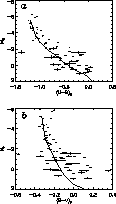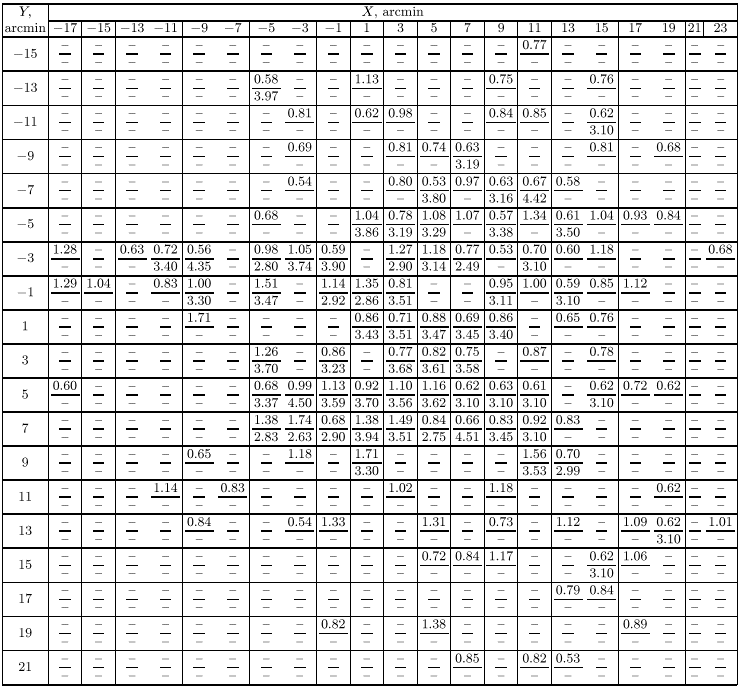NGC 6611 is the extremely young open cluster associated with the nebula M 16. High and variable reddening and an anomalous extinction law were observed in this region (e.g. Sagar & Joshi 1979; Thé et al. 1990; Hillenbrand et al. 1993; De Winter et al. 1997). Therefore, the assumption of an average value of the color excess E(B-V) and RV = AV / E(B-V) for all cluster stars may lead to incorrect results and conclusions by a study of cluster properties.
To improve the statistics of individual E(B-V) and RV data,
we applied the Q-method technique to multicolor CCD observations
of
Hillenbrand et al. (1993).
Stars with ![]() and
and
![]() were taken into account and numerical parameters from
Johnson (1966)
and
Hillenbrand et al. (1993)
were used:
were taken into account and numerical parameters from
Johnson (1966)
and
Hillenbrand et al. (1993)
were used:
 |
||
and
 |
||
The following data sources (listed according to their priority) were included in the absorption study and reddening map construction:
As a result, the sample for the absorption study
includes 467 stars with color
excesses (97 from this catalogue and 370 via the Q-method). For
174 of them, RV determinations are available
(37 from
De Winter et al. 1996
and 137 from the Q-method).
According to the determined membership
probabilities, this sample consists of 221 probable cluster members
(![]() ) and 246 field stars (
) and 246 field stars (![]() ). For the construction
of the reddening map, only cluster members were considered, whereas for the
RV-map all stars with known RV were used.
). For the construction
of the reddening map, only cluster members were considered, whereas for the
RV-map all stars with known RV were used.
 |
Figure 9:
Reddening free color-magnitude diagrams of NGC 6611 stars.
Panel a) MB - (U-B)0, panel b) MV - (B-V)0. Stars with
|
Color excesses and RV coefficients, averaged over small cells
of ![]() are given in Table 4
(with E(B-V)
as upper line and RV as lower line in each box). For illustration,
we show in Fig. 6 the corresponding distribution of E(B-V) over
the cluster area. The map covers a sky region of
are given in Table 4
(with E(B-V)
as upper line and RV as lower line in each box). For illustration,
we show in Fig. 6 the corresponding distribution of E(B-V) over
the cluster area. The map covers a sky region of ![]() and, according to the cluster structure parameters given in Table 3,
it includes both cluster core and corona.
and, according to the cluster structure parameters given in Table 3,
it includes both cluster core and corona.
 |
with
and i running through the sample. According to preliminary tests on the smoothing parameter h in an appropriate range of [0.1, 2.0], we chose h=1.0 as the best compromise to avoid statistical noise and to prevent an oversmoothing of the distribution.
According to Fig. 7, distributions of
cluster members with proper motion probabilities ![]() or
or
![]() show a similar behaviour and differ significantly
from the distribution of field stars. This fact may be interpretated
as an independent evidence for the correctness of the kinimatic
selection procedure.
show a similar behaviour and differ significantly
from the distribution of field stars. This fact may be interpretated
as an independent evidence for the correctness of the kinimatic
selection procedure.
In contrast to the distribution of the cluster members, the distribution
of field stars
shows two distinct components. We attributed a low-absorption peak at
![]() to the foreground field, while the second peak at
to the foreground field, while the second peak at
![]() includes background stars highly obscured by the
cluster parent cloud. Unfortunately, we cannot make more concise
quantitative conclusions due to strong selection effects influencing the
sample of stars with available individual E(B-V) values.
includes background stars highly obscured by the
cluster parent cloud. Unfortunately, we cannot make more concise
quantitative conclusions due to strong selection effects influencing the
sample of stars with available individual E(B-V) values.
The location of distribution features obtained for cluster candidates
coincides well with the positions of the maxima of the E(V-K)/E(B-V)
distribution in Fig. 6 of
Hillenbrand et al. (1993).
Assuming an average of E(B-V)=0.79, the peaks at RV=3.1 and RV=3.75
correspond to ![]() and
and ![]() .
.
Considering the local minima in the cluster member distributions over AV,
we divided 221 cluster members (![]() ) into four absorption groups
indicated in Fig. 7 by vertical lines.
The spatial distribution of these stars is
shown in Fig. 8.
This distribution confirms a patchy behavior of
absorption over the cluster. The most obscured stars are observed
within a strip located to the NW of the cluster core. The less
obscured group (
) into four absorption groups
indicated in Fig. 7 by vertical lines.
The spatial distribution of these stars is
shown in Fig. 8.
This distribution confirms a patchy behavior of
absorption over the cluster. The most obscured stars are observed
within a strip located to the NW of the cluster core. The less
obscured group (![]() ) is randomly distributed within
the core and corona whereas stars with
) is randomly distributed within
the core and corona whereas stars with ![]() which could be
considered as typical for this cluster
unifomly fill the corona area.
The stars absorbed least
(
which could be
considered as typical for this cluster
unifomly fill the corona area.
The stars absorbed least
(![]() ) mark a "transparency'' window in the SE sector
of the corona. Note that stars of other groups tend to avoid the
window.
) mark a "transparency'' window in the SE sector
of the corona. Note that stars of other groups tend to avoid the
window.
 |
||
The ZAMS calibrations were taken from
Schmidt-Kaler (1982).
The distance modulus resulting from a fit of the ZAMS to the
upper part of the CMDs (![]() ) was derived as
) was derived as ![]() which is in good agreement with
Hillenbrand et al. (1993)
(
which is in good agreement with
Hillenbrand et al. (1993)
(![]() ). The corresponding distance is
). The corresponding distance is
![]() kpc.
kpc.
Copyright The European Southern Observatory (ESO)